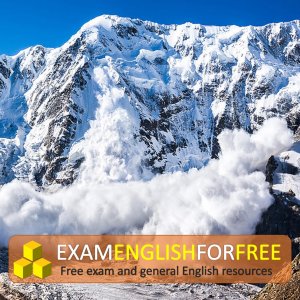Free PTE reading practice 2 – Single answer multiple choice
There are two types of multiple choice question in the PTE test. The first is where you need to select the single correct answer from four possible options, and the other is where you need to select ALL the correct answers from 5 or more options.
In this post, we will practice multiple choice questions with a single correct answer. Read the text below and answer the 2 multiple choice questions that follow.
Avalanches!

There are various classification systems for avalanches, but none that is universally recognized. Canada and the United States use one system, defining risk levels using various factors, while Europe employs a different rating system with different criteria, and other alpine nations utilize varying systems which reflect different aspects of risk and outcomes. Avalanches pose a constant threat, and work is constantly being done to forecast, and mitigate, the risks and outcomes of avalanches. Survival is possible for those caught in this most terrible of natural circumstances, and future work and investigation is vital to ensure the safety of those caught in one of nature’s most destructive forces.
(264 words)
Choose the appropriate letters A – D and write them in boxes 25 and 26 on your answer sheet.
According to the text, which of these measures are used to control avalanches?
Large weapons are fired in mountainous areas to create sound waves.
Helicopters are used to blow the snow off mountainsides.
Teams of men manually move densely-packed snow away from inhabited areas.
Snow shelters are used.
Which of the following is true regarding the classification systems for avalanches?
Canada and the United States do not use the same factors to compare risk.
Classifications are used to determine the duration of an avalanche.
The systems vary in different areas of the world.
The European criteria to classify avalanches is the most widely used.
Click here for the answers and explanations
Free PTE reading practice 2 – answers:
Answer #1:
Large weapons are fired in mountainous areas to create sound waves.
This is the correct answer. The first paragraph mentions control and refers to cannons (which are large weapons) ‘which trigger shock waves…’.
Helicopters are used to blow the snow off mountainsides.
This is NOT the correct answer. The second option is not correct because although the text mentions helicopters, there is no reference to them being used to blow snow away.
Teams of men manually move densely-packed snow away from inhabited areas.
This is NOT the correct answer. The third option is also incorrect because there is no reference to teams of men.
Snow shelters are used.
This is NOT the correct answer. The final option looks like a good answer as it is explicitly mentioned in the text, but it does not directly control the avalanche – it simply gives some protection against the force of the avalanche.
Answer #2:
Canada and the United States do not use the same factors to compare risk.
This is NOT correct. The text states that these two countries use use one system, and decide on risk levels using various factors. This is a commonly confused question – incorrectly matching do not use the same factors in the question with various factors in the text can lead to an incorrect answer.
Classifications are used to determine the duration of an avalanche.
This is NOT correct. The text does state that work is constantly being done to forecast the risks and outcomes of avalanches, but there is no reference to how long an avalanche may take.
The systems vary in different areas of the world.
This is correct. different countries, such as Canada and the US use one system, Europe uses another, and ‘other alpine nations utilize varying systems…’
The European criteria to classify avalanches is the most widely used.
This is NOT correct. The text only mentions that Europe uses different criteria, but no reference is made to whether it is the most widely used. An important note here – regardless of what you feel or believe to be true, unless it is given in the text then you should not select it as the correct option. For example, if there was a multiple choice question asking about the colour of milk and one of the answers is ‘white’, DO NOT select this answer unless it is confirmed in the text.
We hope this free PTE reading practice 2 has helped! Make sure to take a look at our other PTE resources and practice exercises here.
